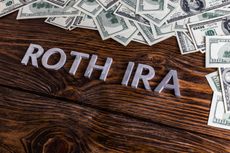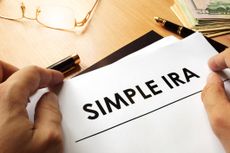Retirement Planning Checklist
Smart retirement planning looks different for those who are ten, five or even just one year away from leaving work.


Ideally, you should start ticking off a to-do list of retirement planning tasks on the day you receive your first paycheck. But in reality, most of us don’t focus on retirement until much later — and that’s fine, as long as you’ve been saving throughout your career. Once you reach your fifties, though, it’s time to start thinking about when you’ll retire, where you’d like to live, and how you’ll spend your time once you stop working.
Retirement planning is in flux
While the pandemic threw a wrench in some retirement plans, it has created opportunities, too. The personal savings rate has soared, as Americans who were able to keep their jobs stashed their stimulus checks, along with money they would normally spend on restaurants and travel, in savings accounts. Instead of allowing that money to languish in a low-interest account, consider using it to beef up your retirement savings.
With the caveat that the when of retirement may be out of your control—if you’re, say, forced to retire earlier than planned or need to stay on the job longer to make up for gaps in your savings—here’s a list of items to check off when you’re 10 years, five years and one year away from your expected retirement date.

Sign up for Kiplinger’s Free E-Newsletters
Profit and prosper with the best of expert advice on investing, taxes, retirement, personal finance and more - straight to your e-mail.
Profit and prosper with the best of expert advice - straight to your e-mail.
10 years until retirement
Retirement is on the horizon, but other matters—your family, your job, your kitchen renovation—tend to consume most of your attention. Still, it’s not too soon to start running the numbers, ideally with the help of a certified financial planner, to get a sense of whether your planned retirement date is realistic.
In the wake of the COVID-19 pandemic, you may need to make some course corrections. More than 80% of Americans say the pandemic has affected their retirement plans, and one-third estimate that they’ll need two to three years to get back on track, according to a survey conducted by Fidelity Investments. The Coronavirus Aid, Relief and Economic Security (CARES) Act enacted early last year allowed people who suffered financial setbacks as a result of the pandemic to withdraw up to $100,000 from their 401(k) or other employer-provided retirement plans without paying a 10% early-withdrawal penalty. If you took a hardship withdrawal (and your employer allows it), you have up to three years to repay the funds and have the repayment treated as a tax-free rollover. (If you repay the distribution after you’ve paid taxes on it, you can file an amended return and get a refund.) The sooner you repay any hardship withdrawals, the more time your money will have to grow. Similarly, while the CARES Act gave borrowers six years instead of five to repay 401(k) loans, the sooner you repay the loan, the sooner you’ll be able to take advantage of market gains on a bigger balance.
Use your stimulus check or other money you’ve saved to increase contributions to your retirement plans. If you’re 50 or older, you can stash up to $26,000 in your 401(k) or other employer-sponsored retirement savings plan. You can also contribute up to $7,000 (if you’re age 50 or older) to a traditional IRA or, if you don’t earn too much to qualify, a Roth IRA (see below).
If your employer offers one, consider shifting some of your 401(k) contributions to a Roth 401(k). Having all of your savings in tax-deferred 401(k) plans and traditional IRAs can result in big tax bills when you start taking withdrawals, says Karen Van Voorhis, a CFP in Norwell, Mass. And while many dual-income married couples earn too much to contribute to a regular Roth, there are no income limits on contributions to Roth 401(k) plans.
Contribute to a health savings account. In 2021, workers age 55 and older who are covered by a high-deductible health insurance plan can contribute up to $4,600 to an HSA. You can use the money to pay for medical expenses that aren’t covered by your insurance, but if you pay those expenses out of pocket and let the money in your HSA grow until you retire, you’ll have a stockpile of tax-free money to pay for medical expenses that aren’t covered by Medicare. Many plans let you invest contributions in mutual funds or exchange-traded funds.
Pay off high-interest debt, such as credit cards or PLUS loans you took out for your children’s college education. Nearly one-fourth of retirees say that debt has made it more difficult for them to live comfortably in retirement, according to the Employee Benefit Research Institute’s 2021 Retirement Confidence Survey. With interest rates at record lows, though, paying off your mortgage before you retire may not be the best use of your money (see below).
Create (or update) your estate plan, which should include a will or trust, health care proxy and power of attorney. Review beneficiaries on insurance policies and retirement plans.
Rebalance your portfolio. It’s too soon to make a big shift from stocks to conservative investments, because you’re still years away from retirement. But the stock market has been going gangbusters for months, which means you may have more invested in stocks and stock funds than you’re comfortable with. For example, if your target asset allocation is 80% stocks and 20% bonds and cash, you may need to sell some stock funds to get your portfolio back on track.
Take advantage of a drop in income
The economy has begun to rebound this year, but many workers are still unemployed or have seen their hours reduced, and some have voluntarily taken time out to care for at-home children. If you fall into that camp, you may be able to take steps that will reduce your tax bill when you retire.
If the reduction in your income caused you to drop into a lower tax bracket but you’re still in good financial shape, this year may be the ideal time to convert some of the money in your traditional IRA to a Roth, says Karen Van Voorhis, a certified financial planner in Norwell, Mass. You’ll pay taxes on any money you convert, but you’ll pay less than you would owe in higher-income years. And once you retire, withdrawals from your Roth will be tax-free, as long as you’re 59½ or older and have owned a Roth for at least five years.
A decline in your household income could also make it possible for you to contribute to a Roth. If you’re married and file jointly, you can’t contribute the maximum to a Roth IRA if your 2021 modified adjusted gross income is more than $208,000. If your household income falls below that threshold this year, you have until April 15, 2022, to contribute to a Roth. Each spouse can contribute up to $6,000 in 2021, or $7,000 if they’re 50 or older.
5 years until retirement
It’s not too soon to start estimating what your expenses will be in retirement, which is critical to determining whether you can afford to retire in five years. If you spent the pandemic working from home, you may have a pretty good idea of how much you’ll save when you’re no longer commuting or having your clothes dry cleaned. But don’t lowball your post-retirement expenses. Many retirees see their expenses go up in the early years of retirement, when they’re still healthy enough to pursue activities they didn’t have time to enjoy while they were working. And if you plan to retire before age 65, you’ll need to budget for health insurance, too.
To get a handle on your cost of living in retirement, comb through your credit card and bank statements to get an idea of how much you spend each month on everything from gas to pet care. Once you’ve done that exercise, use a retirement budget worksheet, such as the one offered at http://investor.vanguard.com/calculator-tools/retirement-expenses-worksheet, to estimate your expenses in retirement.
Then, consider sitting down with a CFP to determine whether you’ve saved enough to afford the lifestyle you’ve envisioned. You may conclude that working a year or two longer will significantly enhance your retirement security (see The Benefits of Working Longer).
Add up sources of guaranteed income, such as Social Security and a pension, if you’re eligible for one. If you don’t have an online Social Security account, go to www.ssa.gov/myaccount/create.html to set one up.
Once you’ve signed up for an online account with Social Security, review your earnings history to make sure you’ve received credit for every year you worked. Your benefits could be shortchanged if an employer reported earnings under an incorrect name or Social Security number.
If you’re concerned that you haven’t saved enough, look into the possibility of a phased retirement. For example, instead of quitting your job in five years, ask your employer if you could continue to work two or three days a week.
Explore part-time positions or gig-economy jobs that will generate additional income in retirement. Check out www.sidehusl.com, which reviews and rates online job sites, for leads on companies that offer part-time work for retired professionals.
If you plan to relocate in retirement, start visiting potential destinations. Many people dream of retiring to an area they’ve visited on vacation, but that’s not the same as living like a local. Try to visit at different times of the year, and take advantage of short-term rental properties or Airbnbs.
Plan for the cost of long-term care. Premiums for long-term care insurance rise as you age, so this may be your last chance to purchase a policy you can afford. While the pandemic made many seniors wary of nursing homes, most current policies provide a pool of benefits that include coverage of home health care. Talk to an insurance agent who represents a number of companies so you can compare coverage and costs. (A CFP can also help you determine whether you have sufficient assets to cover long-term care on your own or in conjunction with a smaller policy.)
Start shifting some of your savings to more-conservative investments—but be careful. With interest rates so low, an overly conservative portfolio could lag inflation, exposing you to the risk of running out of money. Many workers at this stage of their lives opt for a 60-40 allocation—60% stocks, 40% in government bonds—but with interest rates at record lows, you may need to diversify that portion of your portfolio with funds that invest in triple-B-rated corporate bonds, preferred stocks, convertible bonds and real estate investment trusts (see 35 Ways to Earn Up to 10% On Your Money).
Prepare for the unexpected. Nearly half of retirees surveyed by the Employee Benefit Research Institute said that they retired earlier than expected. Many people end up retiring earlier than planned because of layoffs or health issues. Make sure you have at least a year’s worth of expenses in an emergency account so your retirement savings can continue to grow.
Consider keeping your mortgage
It’s hard to put a price on the peace of mind that comes from retiring debt-free, and there’s no question that you should strive to pay off high-interest debt before you stop working. But with mortgage rates at record lows, paying your mortgage off early may not be the best use of your money, financial planners say.
For example, you shouldn’t pay off your mortgage unless you’re already contributing the maximum to your retirement-savings plans. If you have a 30-year mortgage with a 3% interest rate, there’s a good chance you’ll earn more on your investments than you’ll save on interest. Likewise, don’t drain your emergency savings to pay off the mortgage. And even if you check both of those boxes, you should pay off your mortgage only if you have enough money in taxable accounts to pay for it, says David Foster, a certified financial planner in St. Louis. Taking money out of a traditional IRA or 401(k) will likely trigger a significant tax bill, he notes.
Still, when it comes to the appeal of retiring mortgage-free, “the math may say one thing, but your heart says something else,” says Jeremy Finger, a CFP in Myrtle Beach, S.C. If you can retire your mortgage without jeopardizing your retirement savings—or triggering a big tax bill—go ahead and pay it off, he says. Alternatively, consider accelerating the payoff, either by making extra payments or by refinancing to a shorter term. That way, you can retire mortgage-free, or with only a few years to go until the loan is paid off, without depleting your cash reserves.
1 year until retirement
With retirement so close, you may find yourself browsing catalogs or websites for cruises or walking tours. But even if you’re convinced you’ve saved enough to retire in a year, you’ve still got plenty of work to do—and big decisions to make. Start by sitting down with your human resources department to review your pension (if you have one), any retiree health care coverage and other benefits. In some cases, postponing retirement by just a few months could affect your monthly pension payout or your 401(k) match, so be judicious when setting a date for your departure.
This is also a good time to refine the budget you created at the five-year point. You should have a better idea of how you’ll spend your time and how much those endeavors will cost. And if you’ve decided to downsize or move to a lower-cost area, you should be able to estimate how reducing your cost of living will affect your budget.
Determine when you’ll apply for Social Security. Use your online account to review how much your benefits will contribute to your retirement income. Most boomers are eligible for full retirement benefits at age 66, but if you delay until age 70, you’ll receive a delayed-retirement credit of 8% a year.
Start exploring your Medicare options. If you’re approaching age 65, you’re probably already receiving lots of mail from various Medicare Advantage, medigap and Part D prescription plans. You’ll be in a much better position to choose a plan that’s right for you if you start reviewing your options at least a year in advance, says Kari Vogt, a CFP and Medicare insurance broker in Columbia, Mo. Planning ahead will also help you avoid gaps in coverage that could trigger costly Medicare penalties.
If you’re eligible for a traditional pension, review the pros and cons of taking a lump sum versus a monthly payout. A CFP can help you consider which option works best for you and your spouse.
Decide what to do with money in your current employer’s 401(k) plan. Rolling the money into an IRA may offer more flexibility when you take withdrawals, but some 401(k) plans provide institutional-class funds with lower fees.
Simplify your finances. If you have 401(k) plans with former employers, consider consolidating them into an IRA so you can reduce paperwork, review your investment allocation and possibly lower some of your account expenses.
Go to www.missingmoney.com or www.unclaimed.org to make sure you haven’t lost track of any former employers’ pension benefits, retirement plans, bank accounts or other funds.
If you have decided on a retirement destination, step up your research. Subscribe to the local paper, talk to real estate agents in the area, and research local hospitals and health care providers.
Come up with a plan for charitable giving. Many retirees want to support their favorite causes but don’t have a strategy, says David Foster, a CFP in St. Louis. You can do the most good by making scheduled contributions a part of your budget, he says.
Create a bucket system
One of the challenges facing retirees is preserving enough of their savings to protect them from bear markets while keeping enough invested in stocks to stay ahead of inflation. A system that divides your savings into three “buckets” can solve this dilemma. Set aside enough cash in the first bucket to cover living expenses for the first year or two of retirement that won’t be covered by Social Security, a pension and/or an annuity. In the second bucket, invest what you expect to need in the next 10 years in short- and intermediate-term bond funds. The third bucket will hold money you won’t need until much later, which means you can invest it in stocks and alternative investments. Review your cash bucket annually to determine whether it needs to be replenished from your other buckets. If the stock market takes a dive, you’ll have enough in your first two buckets to cover expenses for years, giving your stocks plenty of time to recover.
Get Kiplinger Today newsletter — free
Profit and prosper with the best of Kiplinger's advice on investing, taxes, retirement, personal finance and much more. Delivered daily. Enter your email in the box and click Sign Me Up.

Block joined Kiplinger in June 2012 from USA Today, where she was a reporter and personal finance columnist for more than 15 years. Prior to that, she worked for the Akron Beacon-Journal and Dow Jones Newswires. In 1993, she was a Knight-Bagehot fellow in economics and business journalism at the Columbia University Graduate School of Journalism. She has a BA in communications from Bethany College in Bethany, W.Va.
-
 Average Net Worth by Age: How Do You Measure Up?
Average Net Worth by Age: How Do You Measure Up?Financial advisors discuss the secrets to growing your net worth over time.
By Adam Shell Published
-
 Three Charitable Giving Strategies for High-Net-Worth Individuals
Three Charitable Giving Strategies for High-Net-Worth IndividualsIf you have $1 million or more saved for retirement, these charitable giving strategies can help you give efficiently and save on taxes.
By Joe F. Schmitz Jr., CFP®, ChFC® Published
-
 457 Plan Contribution Limits for 2025
457 Plan Contribution Limits for 2025Retirement plans There are higher 457 plan contribution limits for state and local government workers in 2025 than in 2024.
By Kathryn Pomroy Last updated
-
 What Does Medicare Not Cover? Seven Things You Should Know
What Does Medicare Not Cover? Seven Things You Should KnowHealthy Living on a Budget Medicare Part A and Part B leave gaps in your healthcare coverage. But Medicare Advantage has problems, too.
By Donna LeValley Last updated
-
 13 Smart Estate Planning Moves
13 Smart Estate Planning Movesretirement Follow this estate planning checklist for you (and your heirs) to hold on to more of your hard-earned money.
By Janet Kidd Stewart Last updated
-
 Medicare Basics: 11 Things You Need to Know
Medicare Basics: 11 Things You Need to KnowMedicare There's Medicare Part A, Part B, Part D, Medigap plans, Medicare Advantage plans and so on. We sort out the confusion about signing up for Medicare — and much more.
By Catherine Siskos Last updated
-
 Six of the Worst Assets to Inherit
Six of the Worst Assets to Inheritinheritance Leaving these assets to your loved ones may be more trouble than it’s worth. Here's how to avoid adding to their grief after you're gone.
By David Rodeck Last updated
-
 SEP IRA Contribution Limits for 2024 and 2025
SEP IRA Contribution Limits for 2024 and 2025SEP IRA A good option for small business owners, SEP IRAs allow individual annual contributions of as much as $69,000 in 2024 and $70,000 in 2025..
By Jackie Stewart Last updated
-
 Roth IRA Contribution Limits for 2024 and 2025
Roth IRA Contribution Limits for 2024 and 2025Roth IRAs Roth IRA contribution limits have gone up. Here's what you need to know.
By Jackie Stewart Last updated
-
 SIMPLE IRA Contribution Limits for 2024 and 2025
SIMPLE IRA Contribution Limits for 2024 and 2025simple IRA The SIMPLE IRA contribution limit increased by $500 for 2025. Workers at small businesses can contribute up to $16,500 or $20,000 if 50 or over and $21,750 if 60-63.
By Jackie Stewart Last updated